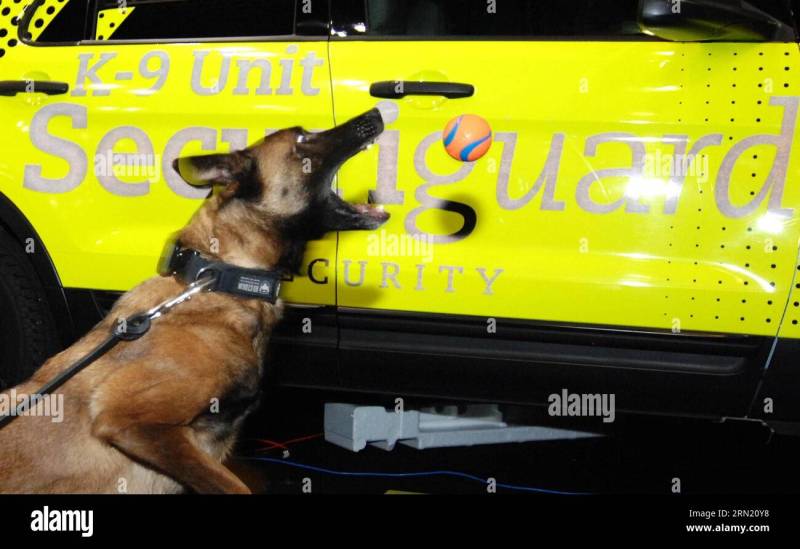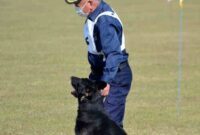Detection Dog Skills – Dogs and humans have shared an extraordinary bond for thousands of years. DNA evidence shows that dogs are descended from ancient wolves and were domesticated 100,000 years ago. The function of dogs is believed to date back to prehistoric times when dogs helped nomadic peoples in their search for food. As time went on, their work expanded to herding and guarding fields and crops, and since the earliest human settlements, dogs have provided us with their protection, their vigilance, and their devoted companionship. Today, they can be classified as “working dogs”.
The deep bond that has developed between dogs and humans over the centuries is reflected in the way dogs work, play and live with us. By building this real bond, it becomes clear that dogs have empathy and a “dog spirit” that is evident in the way they communicate with us so much through their noses, ears, eyes and touch.
Detection Dog Skills

A dog’s most strongly developed sense is undoubtedly the sense of smell or smell. Senior Lecturer in Community Practice at Cornell University College of Veterinary Medicine and Cornell Richard P. Fellow Canine Health Center Dr. In a recent conversation with Brian Collins, , or smell, is highly developed. Along with their exceptional memory and ability to learn, their ability to identify odors makes them highly valuable for detecting potential threats and security issues at airports.
How Do They Train Drug Sniffing Dogs?
Their unique anatomical and physiological characteristics allow them to detect and identify odors at extremely low levels, even defying the limitations of technology. Their ability to detect and recognize chemical cues is approximately 10,000 to 100,00 times greater than that of humans, making them extremely useful in identifying target odors, such as drugs and explosives, and training them to focus on specific individuals. ‘
Native tribes had large, movable ears that allowed them to hear sounds from afar. Some species have more acute hearing than others, but all can detect sounds more acutely than the human ear, and they can hear sounds at much higher frequencies than humans. Dogs are also able to fine-tune their inner ears and filter out distracting sounds. Their ears can have up to 18 muscles that allow them to move and rotate independently so they can distinguish between sounds and absorb more information.
Although their eyesight is not as strong as their sense of smell, dogs can generally see better in low light than humans. Their field of vision is wider because their eyes are further back in their heads, so they are not as good at focusing on near objects and judging distance, but they are very good at detecting movement. Dogs also have a third eyelid which is a membrane that protects the eye from irritation and produces tears.
Dogs are sensitive to touch and use this sense to communicate with other dogs and their humans. Touch-sensitive hairs called vibrissae or whiskers, which grow above the eyes and under the jaw, are able to sense air flow and help the dog feel changes when it approaches an object without touching it.
Explosive Detection Dog Team
At airports, detection dogs are trained to detect target odors and alert their handlers. This is known as printing. Imprinting is the basis of canine detection, where the dog learns how to identify and respond to a target’s scent. Due to dogs’ excellent sense of smell, the list of detectable scents varies, but the main target scents include explosives, illegal narcotics, firearms, fire accelerants, cash and other contraband.
In 1984, beagles were first put to work by the US Department of Agriculture (USDA) when the “Beagle Brigade” was formed at Los Angeles International Airport.
In March 2023, JFK International Airport’s Ark, which is dedicated to the well-being of pets in transit, cited an article about the ARK pet oasis [Billis, M. (2019, December) Why the US Has So Many Canine Workers. There are airport beagles,

], reports that approximately 120 dog teams are employed at airports, cargo warehouses, shipping terminals, and ports of entry. The working dogs in the Beagle Brigade are primarily USDA. Training is provided in a facility managed by National Detector Dog Training Center (NDDTC) in Georgia. All detector dogs at NDDTC are adopted from rescue shelters in the United States or come to the program from private donations. The center is a primary training facility for selected dogs to inspect international passenger baggage, cargo and packages, prohibited agricultural products that may carry exotic plant pests or animal diseases into the country. These dogs are trained to detect certain fruits, vegetables and meat that can damage the country’s fields, forests and crops, costing the US billions of dollars a year while also having a devastating effect on the country’s agricultural producers.
Hero Detection Dog Protects Owner With Severe Peanut Allergy
The US Transportation Security Administration (TSA) has managed canines in airport environments for nearly 15 years and has played a key role in improving airport security and enhancing the passenger experience. TSA’s National Explosive Detection Canine Program trains and deploys canine teams led by TSA and state and local law enforcement in support of day-to-day activities that secure the transportation domain. These highly trained explosive detection canine teams are a reliable resource for explosive detection and provide visible protection against terrorism targeting the transportation system. The Explosive Detection Canine Training Program is the largest explosive detection canine program in the Department of Homeland Security and the second largest in the federal government after the Department of Defense.
TSA training teams include transportation security inspectors and local or state law enforcement officers who are paired with explosive detection dogs that work at airports, freight facilities and other mass transit facilities across the country. TSA provides and trains a dog, handler and training assistants and explosives magazines, and conducts annual canine team certifications on site.
James Fitzgerald is the Assistant Federal Security Director for Inspections at the Transportation Security Administration based at JFK International Airport. In a recent interview with
, he talked about the origins of TSA’s airport explosive detection canine program. Because the infrastructure and equipment are not yet in place, the TSA has set up a canine program to help inspect cargo. As of 2015, with all the equipment, training and everything needed to screen cargo, TSA moved canine operations from cargo areas to airport terminals where we have our own teams focused on screening passengers and their accessible property. Cargo screening has since been outsourced to third-party TSA-certified canine detection teams contracted to assist agencies, although we are always there when needed. “
Signal Detection Theory With Dr. Simon Gadbois
Fitzgerald noted, “Canine detection does two things for us… it gives us another layer of security, and not only does it help our effectiveness in assisting our mission in detecting lethal or dangerous objects in the area and on aircraft. But it also helps the customer experience by making the air travel process a little more streamlined and efficient. From that point of view, the community likes it, because it helps to try to get people on one side of the public area into a sterile area, and it’s such an effective tool. “Most people really like dogs, but some people may be culturally concerned, so we make provisions for them to walk dogs.”
Conventional explosive detection dog handlers go through an 11-week training course and passenger screening dog handlers go through a 16-week training course. Canine teams graduate from the TSA canine course after demonstrating proficiency in a variety of locations including airports, terminals, baggage, freight and cargo facilities in all transportation environments. After the team graduates from the training program, they return to their duty station to acclimate and familiarize the dog with their assigned operating environment. Each team is continuously evaluated to see if the dogs demonstrate functional proficiency in their environment, including four key components: the dog’s ability to detect explosive odors, the handler’s ability to interpret changes in the dog’s behavior, and the handler’s ability to execute logically and systematically. The team’s ability to detect and locate the source of an explosive odor.
Located at Joint Base San Antonio-Lackland in San Antonio, Texas, the $12 million dog training center includes 25,000 square feet of space with seven classrooms, 140 employees and office space with a 100-seat auditorium. The premises have 17 enclosed spaces that simulate different locations and modes of transport. In the context of an airport, it includes a cargo facility, an airport gate area, a checkpoint, a baggage claim area, an aircraft interior, an air cargo facility, two mock terminals, and open areas to detect air scent sites. The kennel can accommodate around 350 dogs. A dog breeds

Detection dog training, scent detection dog training, dog skills, allergy detection dog, bed bug detection dog, detection dog, gluten detection service dog, seizure detection dog, explosive detection dog, detection dog handler training, gluten detection dog, diabetes detection dog
- Search Rescue Dogs - July 29, 2024
- Police Dog Training - July 25, 2024
- Pointing Dog Training - July 25, 2024




